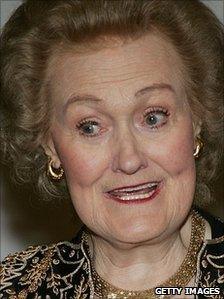Obituary: Dame Joan Sutherland
- Published

Dame Joan Sutherland received a Kennedy Center Honor in 2004
When Joan Sutherland took her curtain call at the end of the 1959 production of Donezitti's Lucia di Lammermoor, the Covent Garden audience gave her a 19-minute ovation.
The unpretentious, somewhat gauche Australian singer, who had arrived in Britain with little knowledge of stagecraft, had become an overnight sensation.
Joan Sutherland was born into a musical family in Sydney on 7 November 1926. Her mother was a talented mezzo soprano who had given up her career but still practised at home. She encouraged her daughter to listen to opera and to sing with her at the family piano.
Sutherland began singing seriously at the age of 18 and in 1949, won Australia's most important competition, The Sun Aria. She went to London to study at the Royal College of Music.
Having appeared in a production of Dido and Aeneas in Australia, she made her European debut as the First Lady in Die Zauberflöte at the Royal Opera House, Covent Garden, on 28 October 1952.
Later that year she appeared alongside Maria Callas in four performances of Bellini's Norma, also at Covent Garden. By this time she had improved her stagecraft under the tutelage of opera director Norman Ayrton. He taught her the importance of moving on the stage and, famously, how to fall gracefully, something she used to great effect in both Lucia and Lucrezia Borgia.
Dame Joan was created CBE in 1961 and elevated to Dame Commander in 1978.
Trained in the Wagnerian style, she sang her first leading role as Amelia in Somma's Un Ballo in Maschera, and followed this up with Aida. In 1953 she married a fellow Australian, the concert pianist Richard Bonynge.
Despite opposition from opera managers, and from her own mother, he persuaded her to concentrate on the somewhat neglected bel canto roles. He felt her voice was better suited to the evenness and light upper register demanded by this style of singing which had fallen out of favour during the mid 19th century.
In 1959 she was invited to sing Lucia di Lammermoor at Covent Garden in a production conducted by the Italian maestro Tulio Serafin and staged by Franco Zeffirelli. It was her breakthrough, her performance of the famous Mad Scene earning her critical acclaim.
La Stupenda
A year later, a superb performance of Alcina at La Fenice in Venice led to a knowledgeable and appreciative Italian audience dubbing her La Stupenda.
She continued to add some of the great lead roles to her repertoire. Violetta (La Traviata), Amina (La Sonnambula), Elvira (I Puritani) and Marguerite de Valois (Les Huguenots)
She later added Marie (La Fille du Régiment), a decision that attracted raised eyebrows from some critics but won over audiences with her perfect coloratur and funny interpretation.
Dame Joan performs as the Queen of the Night in The Magic Flute in 1962
She had worked hard on her diction throughout the 1960s which enable her to tackle more challenging roles including Donizetti's Maria Stuarda and Lucrezia Borgia and Massenet's extremely difficult Esclarmonde.
But her voice started to decline towards the end of the 1970s. Nevertheless she continued to tackle new roles her superb technique enabled her to continue at the highest level until her retirement in 1990.
For her final public performance in her native country she reprised the role of Marguerite de Valois in front of a packed audience at the Sydney Opera House. Her farewell to Covent Garden came on New Years Eve1990 in a gala performance of Die Fledermaus.
She was joined on stage by her friends Luciano Pavarotti and Marilyn Horne in an emotional evening at the venue she always referred to as home.
She was created CBE in 1961 and elevated to Dame Commander in 1978.
Joan Sutherland received acclaim, not just for her singing ability but also her warmth and down to earth manner. She would never refuse to meet her public after a performance and take time to chat and sign programmes.
Not for her the flashes of petulance which are exhibited by some of her modern counterparts. She was a consummate professional who once said that she was happy to sing the roles that she was given and obviously took great joy in doing so.
- Published11 October 2010